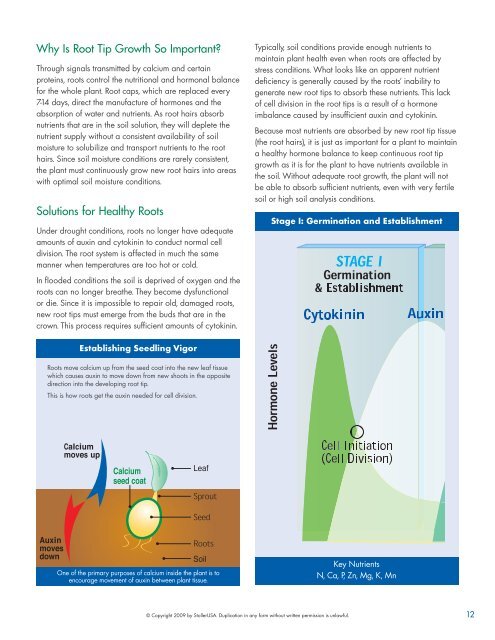You also want an ePaper? Increase the reach of your titles
YUMPU automatically turns print PDFs into web optimized ePapers that Google loves.
Why Is Root Tip Growth So Important?<br />
Through signals transmitted by calcium and certain<br />
proteins, roots control the nutritional and hormonal balance<br />
for the whole plant. Root caps, which are replaced every<br />
7-14 days, direct the manufacture of hormones and the<br />
absorption of water and nutrients. As root hairs absorb<br />
nutrients that are in the soil solution, they will deplete the<br />
nutrient supply without a consistent availability of soil<br />
moisture to solubilize and transport nutrients to the root<br />
hairs. Since soil moisture conditions are rarely consistent,<br />
the plant must continuously grow new root hairs into areas<br />
with optimal soil moisture conditions.<br />
Solutions for Healthy Roots<br />
Under drought conditions, roots no longer have adequate<br />
amounts of auxin and cytokinin to conduct normal cell<br />
division. The root system is affected in much the same<br />
manner when temperatures are too hot or cold.<br />
In flooded conditions the soil is deprived of oxygen and the<br />
roots can no longer breathe. They become dysfunctional<br />
or die. Since it is impossible to repair old, damaged roots,<br />
new root tips must emerge from the buds that are in the<br />
crown. This process requires sufficient amounts of cytokinin.<br />
Establishing Seedling Vigor<br />
Roots move calcium up from the seed coat into the new leaf tissue<br />
which causes auxin to move down from new shoots in the opposite<br />
direction into the developing root tip.<br />
This is how roots get the auxin needed for cell division.<br />
Calcium<br />
seed coat<br />
Leaf<br />
Soil<br />
One of the primary purposes of calcium inside the plant is to<br />
encourage movement of auxin between plant tissue.<br />
Typically, soil conditions provide enough nutrients to<br />
maintain plant health even when roots are affected by<br />
stress conditions. What looks like an apparent nutrient<br />
deficiency is generally caused by the roots’ inability to<br />
generate new root tips to absorb these nutrients. This lack<br />
of cell division in the root tips is a result of a hormone<br />
imbalance caused by insufficient auxin and cytokinin.<br />
Because most nutrients are absorbed by new root tip tissue<br />
(the root hairs), it is just as important for a plant to maintain<br />
a healthy hormone balance to keep continuous root tip<br />
growth as it is for the plant to have nutrients available in<br />
the soil. Without adequate root growth, the plant will not<br />
be able to absorb sufficient nutrients, even with very fertile<br />
soil or high soil analysis conditions.<br />
Stage I: Germination and Establishment<br />
Key Nutrients<br />
N, Ca, P, Zn, Mg, K, Mn<br />
© Copyright 2009 by StollerUSA. Duplication in any form without written permission is unlawful. 12


